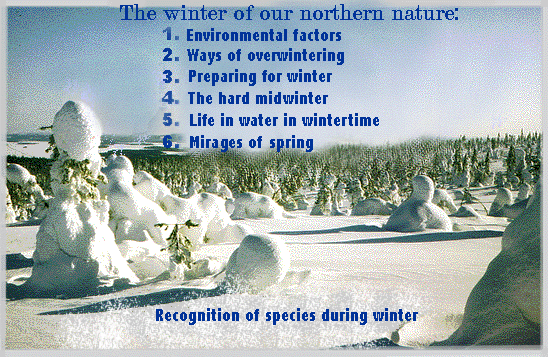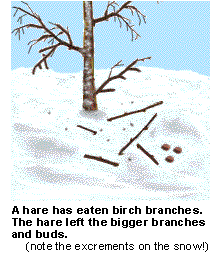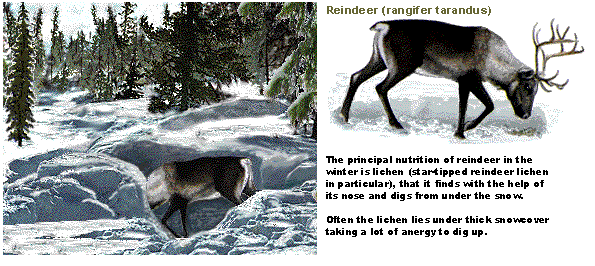To the main menu here!
THE WINTER OF OUR NORHTHERN NATURE:


Hard midwinter/animals:
Sorry but some parts and links are not yet translated!
The link to the hard winter of plants above (here).
Other topics on our northern nature are found from the picture above.
For other topics concerning nature, go to Main menu
In this part: 'Hard midwinter/animals', part 3.
See also the wintering means of animals! and
How animals prepare for the winter!
... and:

Hard midwinter/animals:
Winter nutrition cannot compete with what summer has to offer...
The nutrition available in the winter is sparse and in low energy value.
Squirrels can run out of cones and bullfinchs out of seeds! Though there are plenty of pine twigs for capercaillies and broad leaved trees for hares this sort of nutrition is usually relatively poor in nutrition.

In the winter, many animals eat food stock they have gathered - if they can find them and the supplies have not been eaten by other animals!
The nutrition of most herbivorous animals is totally different in the winter:
a lot dryer, harder and ja woodier. In addition, a part of the food plants have either withered or been covered by snow.
A long appendix contributes to eating woody twigs for nutrition (for example by hares or capercaillies)
Eg. The combined length of a capercaillie's two appendixes is 130-140 cm in the winter but only 110-120 cm in the summer. The fine part of nutrition halts in the appendix to 'melt'.
Instead, the coarse-grained part flows almost straight out as excrements. The coarse material is boweled rapidly but appendixes are emptied more seldom.
Sometimes the soft appendix excrement of a grouse can be seen on top of the more coarse excrement. Hares eat
their soft appendice excrement to collect all available nutrition and to keep the bacterial strain of its intestines high enough.
Predatory mammals and birds eat meat throughout the year but there are some changes in the species of prey in the winter
(eg. migratory birds are absent). Shrewmice - as well as pretators - have the same diet in the winter as in the summer
(beetles, beetle larvae, spiders, worms and snails).
In the winter, competion over nutrition is harder than in the summer...
Competition over nutrition is harder in the winter and especially within each animal species.
Some species avoid competing over insufficient food resources by finding their way into an environment
with as few competitors as possible
Eg. redpolls, siberian tits, pine grosbeaks, dippers and hawk owls migrate from Lapland to southern Finland.
For instance nuthatchs visit Finland from the east. After they run out of their principal diet, the arolla
pine seeds, they begin their migration to find a new supply. See also moving and migrations!
Seeds are very nutritious - if one can find them...
Approximately twenty species of animals eat the seeds of conifer trees
in Finland. They are the principal diet of crossbills, woodpeckers and squirrels, but
redpolls and titmice may also eat the seeds if they can only get to them first.
For instance a bank mole may eat the seeds of a spruce cone.

Bohemian waxwings and fieldfares are the most common eaters of rowan berries.
They eat the fruit flesh but seeds remain capable of germination after they have passed through
the birds' intestines. This is how rowan spreads to new areas. However, bullfinches and pine grosspeaks dig the seeds out
eating nothing more of the berry.
Eg. redpolls and bullfinchs eat the small seeds of broad leaved trees and grass.
The grass seed eaters are divided into two groups: goldfinches and greenfinches like to eat
burdocks ja thistles that have bigger seeds, whereas redpolls ja linnets eat smaller seeds.
Even twigs, buds and bark from trees and bushes will do...
Animals choose their food plants
carefully. Not only do they eat certain species of plants but they also often choose certain inviduals
leaving other plants with less gnawing.
More: Food plants!
Broad leaved trees and bushes give many animals a vast supply of food.
Especially in the winter herbivorous animals favor birches, willows, aspens and rowans.
Hares and grouses avoid birch buds as they seem to contain too much bad-tasting resins.
Many of our deer favor the leaves of bushes.
Moose eats branches throughout the winter but early in the winter it can also eat dward shrubs and ja grass.
The white-tailed deer and roe deer cannot even get grass or twigs after they have been covered with heavy snow.
Eating branches does not satisfy the nutrition needs of these small deer through the whole winter, which prevents
them from spreading north (if not fed by man). Moose survive well through the winter with branches. Reindeer and
wild forest reindeer do not eat a lot of branches.

For the arctic hare (similarly to
the moose), branches are enough to satisfy its daily energy requirements. As the snow cover
thickens, hares can reach higher and higher branches. Crown snow-load may also bend branches to its reach.
The brown hare eats mainly green plants from under the snow, but can also resort to branches (eg. apple trees!).
The grouse eats thin pieces of willow and birch branches in the winter.
When the snow cover is thin it may eat blueberry and dwarf birch twigs.

Animals eating the buds of broad leaved trees and bushes
are the grouse (eats birch catkins and buds), partridge (alder catkins and buds)
and bullfinch (eg. willow, if berries run out). Many animals - eg. moose, hares, willow grouses - eat
the buds of broad leaved trees the same time they eat pieces of branches.
Hares and grouses avoid birch buds as they seem to contain too much bad-tasting resins.
Animals rarely eat tree bark except for emergency nutrition.
When the hare population has grown big and nutrition is scarse, even a hare
barks willows or other broad leaved trees. Sometimes (in northern Finland) it even resorts to
eating the phloemof young pines (like bark bread!). Hares (as well as other mammals)
eat the bark of treetops rather than the bark of the base of the tree if they can only reach it
(fallen trees, especially aspen and birch).
Major part of the beaver's winter nutrition consists of the bark of broad leaved trees
(aspen, big willows, birch). Moose barks broad leaved trees and even pines to satisfy its hunger.
It also rubs its antlers in the autumn to revove skin from them (as reindeer do).
The small mammals field vole ja tundra vole eat tree bark under the snow
(Willows, aspen, birch). From time to time field voles cause damage to ornamental shrubs.
Bank mole eats the bark of fallen trees (pine's and aspen's). In addition it climbs to young pines
over the snow to eat their tops.
See also the winter life of moles under and on top of snow! Especially the bottoms of hawthorns and roses
are sometimes completely eaten in the spring. The aboveground parts of these bushes die but new
sprouts will grow as long as the roots are not damaged. See also
damage caused by the bank mole!
Though there are a lot of conifer tree needles in the woods
they (mostly pine and juniper needles) are only good for a few animals.
Pine needles are the capercaillie's only nutrition during the winter's
period of thick snow.
Needles are difficult to digest but capercaillies have long appendices,
containing bacteria specialized in dissolving needles. The capercaillie chooses to eat the needles
from a tree containing a lot of energy and little resin. Choosing the tree is especially
important because the needles must contain as much energy as possible and be easily digestible.
Choosing the same trees over and over again cause them to thin out. During the winter, capercaillie eats
approximately 150-200 grams of needles. Usually a full stomach contains enough energy for the long winter night.
In the winter, capercaillies avoid moving and spend 90% of their time in a hollow where the temperature
remains tolerable. Sometimes even a grouse eats the needles of a pine as well as thin branches.

Spruce needles are rarely eaten by any animal (except sometimes by a hare).
Moose and both of our hare species eat needles with thin juniper branches. Under the snow even a field vole
may chew the juniper's thin branches.
Pines are the moose's ordinary winter food. It favors the branches of young
(2-3 meter tall) pines causing damage in seedling stands.
Usually pine survives despite the damages caused by the moose, although curving and multiple tops may occur.
Hares may eat pine needles in hunger particularly in northern Finland
Only very few species eat the buds of conifer trees in the winter.
Pine grosbeaks and squirrels are some of the rare spevcies that eat them frequently. Squirrels are most likely to eat the
staminate flower buds, however, this only occurs in bad cone years. Pine grospeaks have developed a special taste for spruce buds.
Sometimes, while climbing in trees, bank moles eat pine buds along with the bark.
It is not always easy to dig food from under the snow...
Getting food from under the snow depends on the thickness of the snow cover.
The brown hare and partridge mainly dig green plants from under the snow on fields.
They both enjoy the sprouts of winter grain but other types of green will do as well.
If the snow is too hard after thaw, digging will not be possible. Emergency nutriotion can be found
from winter juts
(seeds), hay piles in barns or gardens (brown hares eat eg.
the bark of fruit trees). Neither of the species have spread to Lapland where the snow cover is plentiful and
lasts long. However, a reasonable amount of soft snow protects from the cold as well as from predators.
Even the partridge knows how to dig into snow to 'warm up itself'.
Reindeer and wild forest reindeer
dig lichen from under the snow in the woods but in addition grass on fields and
sedge in bogs (especially early in the winter). Digging snow for nothing really does not pay off to the reindeer!
Reindeer at the Kuusamo area give up digging when the hardness of the snow
is only about 100 g/cm3, but in the Kittilä area they will dig a lot harder snow.
(about 1000 g/cm3). This difference may be explained by the fact that in Kuusamo there are alternative types of nutrition to the
reindeer to eat (eg. alectoria in conifer trees).
Reindeer smells lichen
through the snow! More: Reindeer!










